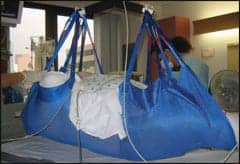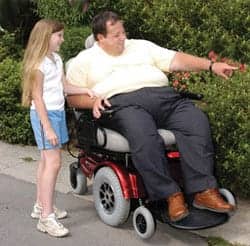 |
| A bariatric patient is hoisted with the use of a ceiling lift to assist in repositioning in bed; the patient weighs 525 pounds. |
As the problem of obesity increases in the United States, there has been a dramatic rise in bariatric surgery and its associated treatment programs. Hospitals and rehab clinics must take a fresh look at the equipment they have readily available to deal with the growing influx of these patients. Everything—from bariatric beds, to ceiling and floor lifts, to seats and commodes, not to mention the protocol for the workers, nurses, and therapists who deal with these patients at the risk of injury to themselves—needs to be reexamined and adjusted accordingly to provide the safest, most effective environment for both patient and clinician.
Three experts in bariatrics analyze both the successes and failures in this burgeoning field and offer their prognosis.
For Michael Dionne, PT, owner of Choice Physical Therapy in Gainesville, Ga, it’s all about equipment. “You can’t do the service safely without the right equipment,” says Dionne. “In fact, I would argue that bariatric home care agencies shouldn’t even accept assignments unless the clients have the equipment to provide adequate care. After all, what does a 110-pound clinician do with a 750-pound patient without the proper equipment?” That particular weight is on the high end, as the realm of bariatrics starts at about 350 pounds.
“Regardless of the specific weight, the number one issue is always whether the equipment is of appropriate capacity for safe and effective treatment of the patients who are seen,” he adds.
Dionne, who has published numerous articles on the subject of bariatric equipment, defines his program as incorporating what he terms the “bariatric triad,” meaning three basic pieces of equipment that must be part of any treatment procedure. These are: 1) an appropriately weight-rated bed—”for a 575-pound patient, you want at least a 700-pound-capacity bed,” 2) the lift—”the argument,” Dionne comments, “is between ceiling lifts and bedside lifts,” 3) target surface—”typically a wheelchair, sometimes ends up being a bedside commode or stretcher chair.”
“The advantage of having these three things,” says Dionne, “is that you can follow the patient through all phases of treatment, from emergency room, to ICU, to acute care, subacute, transitional, nursing home, and finally home care. The equipment triad is constant, and overcomes a failure often associated with what has become known as bariatric suites, which is lack of portability resulting in the patient becoming stranded. What we want to do is transition the patient through the continuum of health care, and portable equipment augments that [goal].”
Regarding protocol for bariatric therapists, Dionne believes it is key to have “evidence-based screening tools to trigger implementation of equipment,” such as the procedure that he devised called the Dionne Egress Test, a screening tool for clearing patients in terms of function before they leave the starting surface. “One of the failures you see in a lot of facilities, even when they have the necessary equipment, is knowing when to trigger or indicate the use of that equipment.”
Also, Dionne continues, most facilities should be going to some form of a no-lift environment, ie, a “manual lift-free zone, regardless of size of the patient, with manual techniques restricted to nonexertion activities.
“Sensitivity,” says Dionne, “is also crucial for therapists in order to create a secure and safe environment where you establish rapport with the patients. Without that rapport, the clinical environment will fail due to stress. You have to have sensitivity training for the staff to help maintain that rapport so they know when to indicate equipment.”
Queried about the general prognosis for most bariatric patients, Dionne responds that weight reduction is the long-term goal, but there must as well be a strong focus on the shorter-term goal of “transitioning the patient through health care in a cost-effective manner.”
Again, for both clinic and home care, Dionne emphasizes that having the equipment triad in place before treatment begins is fundamental to success. “Hospitals,” he concludes, “should not accept bariatric patients without having the proper equipment, nor should they discharge them for home care without that equipment already in place.”
THE CHALLENGE OF BARIATRIC CARE
What’s foremost in the mind of Manon Short, RPT, Tampa General Hospital, Tampa, Fla, is that “bariatric care is difficult.” Echoing the words of Michael Dionne, she says, “It can be a challenge to treat them like every other patient because we just don’t always have the equipment available.”
However, on the upside, she reports that Tampa General has made a lot of changes, and has had a Bariatric Task Force since 2003 “when we started seeing a trend in the United States with obesity rising and the increase in bariatric surgery, resulting in more bariatric patients in the hospital.
“It’s a multidisciplinary task force where we have the therapists, nurses, skin care specialists, a whole group that accommodates the needs of the bariatric patient,” she says.
“We also started a lift team that helps patients get in and out of bed whether or not they’re bariatrics. The teams are especially active with the bariatric population as far as turning and boosting them in bed. They’re a special group of people that the nurses can call upon when a bariatric patient is admitted. We have 26 designated FTEs (full-time equivalent), six during the day and four at night, working in groups of two. Approximately 30% of their call volume is dealing with the bariatric patients.”
Lift team members undergo 2 weeks of training, a lot of it hands-on. Short’s role at the hospital is Injury Prevention Coordinator, “so I manage the lift team and our ergonomic program.” Short has functioned in the coordinator position for 9 years, and before that worked in a rehab center in pain management, where she treated a lot of nurses who had chronic back pain (from lifting patients), “but then they’d go back on the floor and get hurt again.”
According to Short, to remedy this ongoing situation, the lift team was started. “We also purchased more than a million dollars of lifting equipment,” notes Short, who also says the hospital uses a lot of overhead ceiling lifts. “[There are] ceiling tracks above the bed in more than 300 of our 900 rooms, and in our new expansion building, a 50-room critical care unit, every single room has a permanently mounted ceiling lift with an 800-pound capacity,” she says.
Short says the ceiling lifts are primarily used for turning patients. “We apply a sling beneath the patient that stays underneath them permanently, and with just the press of a button, we can turn these patients or boost them up in bed.”
 |
| Manon Short, RPT |
Short believes that bariatric patients, with a BMI of approximately 30 or above, constitute about 10% to 15% of the total patient population in Tampa General, which has been very proactive in procuring the necessary equipment for bariatric care, but she is concerned about other hospitals nationwide. “I speak at a lot of safe patient-handling conferences, and it seems that, nationwide, many hospitals don’t have the equipment to accommodate these patients.”
At Tampa General, her concern is more for the repositioning of the patients. “Turning patients and doing bed changes can be really hard, even with the ceiling lifts. And sometimes we may not have adequate bariatric seating in all areas of the hospital, so having recliners and commode chairs to accommodate these folks can be an issue. But we’re continuously trying to improve the amount of equipment that we have.”
Short mentions that the hospital rents bariatric mobility equipment such as walkers (but doesn’t use scooters), “and companies like Hill-Rom provide us with rentals for bariatric beds and other items such as commodes.
“The rest of the equipment we pretty much own, including the ceiling lifts and Hoyer-type floor lifts. We have a lot of slide sheets to help move patients from bed to bed or bed to stretcher, and several motorized stretchers that will accommodate up to 700 pounds. Our transport department has quite a few 1,000-pound wheelchairs, and we also strive to have adequate seating in waiting areas for our bariatric patients.”
A specific concern for Short is lateral transition on and off the radiology tables and in the operating room. “We don’t have much equipment that will help facilitate these transfers, so we’re hoping in the future to be able to purchase air-inflated hover mats to help with lateral transfers. We want to be able to issue a hover mat upon admission if the patient goes to the operating room, and leave it underneath them for their whole length of stay. The hover mats reduce your pulling force tremendously, and can also be used for repositioning the patients in bed, so there are a lot of advantages to using the product.”
The standard hover mats are expensive at about $2,000, “but,” says Short, “they also have disposable ones that cost only around $100, and we’d like to get some of those, especially since we don’t have in-house laundry; sometimes the mats get lost when they go outside the facility for cleaning. And the disposable ones can be used multiple times for the same patient. They’re patient-specific, so once the patient is discharged, you throw them out.”
Regarding patient skin protection and pressure sores, Short says, “early mobility is the key to preventing those problems, but sometimes therapists are limited with the type of equipment they have. We have a few areas in the hospital where we have overhead lifts with walking slings to help mobilize the patient. Having adequate equipment available to protect the therapist from getting injured is essential. “
Short says, “Unfortunately, a lot of therapists still try to manually handle these patients, and they get hurt. The APTA is working really hard to change the school curriculum to emphasize safe lifting, and I think some PT schools are starting to embed safe patient-handling into their programs, but it’s not yet a standard nationwide. We do get a lot of new grads who know very little about lifting equipment and have been trained just to lift patients manually.
“Buying in to using the equipment is still a big struggle for many therapists. It’s a matter of changing the way you’re accustomed to doing things, as well as receiving the right training in the equipment.”
She sees hope, though, at her own facility. “Here at Tampa General, however, our outpatient therapy people have really become champions in this area. They use ceiling lifts for everything, to walk patients over a treadmill, even to sit a patient on a bicycle. It’s just a matter of becoming comfortable with the equipment over time.
“My main thought about bariatric care,” Short concludes, “is that hospitals not only need to have the proper equipment in place, but also need to gain the support of the nursing and therapy staff through the educational component. We’re still struggling with that, and if you look at the CDC slides, obesity is definitely on the rise.”
Kevin Huffman, DO, Toledo, Ohio, works primarily with hospitals and surgeons treating patients in the 200- to 300-pound category. Like other bariatric specialists, he believes that lift teams are a crucial issue.
“In the past,” he says, “we had no such thing as ‘lift teams’; nobody knew what a lift team was. Now, since the early 2000s, it’s becoming a standard, at least in bariatric institutions whether they’re extended care facilities or hospitals. We had been seeing more and more injuries to nurses and physical and occupational therapists working with these obese patients, and because of the high cost of treating the injuries plus the cost of replacing these workers, the hospitals realized it was more cost-effective to create these lift teams.
“First, these team members need to undergo sensitivity training so they treat the patients with dignity and respect. Then they have to learn how to do this kind of work without injuring anyone on the team.”
Regarding particulars, Huffman explains that a minimum number of persons on the team should be three, with one each on the left and right and another at the head of the patient. “You want to select people for the team who have some experience, including occupational and physical therapists.”
Because of the rapid and explosive growth in bariatric surgery, more and more hospitals have these lift teams and proper bariatric equipment in place, Huffman says. The problem comes in, he believes, with hospitals that say, “Well, we don’t do bariatric patients.” “The next thing you know,” he says, “they get a guy in the emergency room with chest pains who weighs 600 pounds. So all hospitals have to be prepared. Unfortunately, what we’re seeing is that only the bariatric surgical hospitals or extended care facilities that cater to bariatric surgical patients seem to be prepared. The vast majority of facilities are still unprepared.”
Huffman insists that not enough is being done about the lack of lift teams in nonbariatric hospitals. He says, “It costs the hospital 40 to 60 thousand dollars, including training and insurance, to replace an injured [worker]. It’s in the best interest of the hospital, even if they’re not a bariatric facility, to buy the right bariatric equipment, lift equipment, and mobility devices.”
Huffman considers 100 pounds overweight as the minimum standard for consideration as a bariatric patient, “but once they get to a total weight of 350 pounds or above, it’s not only the weight, but also the size, that has to be accommodated, which means “many physical alterations in equipment now have to take place.”
Some of the necessary equipment, according to Huffman, includes lifts that can handle up to 1,000 pounds, as well as bariatric wheelchairs, stretchers, and shower equipment.
|
As medical director for bariatrics rehab company Gendron Inc, the oldest company of its kind in the United States, Huffman implements its “bariatric assessment tool,” which is a questionnaire the company sends to hospitals and outpatient clinics asking about their bariatric beds and equipment. “Then we send someone to the facility to walk through it, looking at the width of the doors, inclines of the hallways, commodes (wall-mounted or floor-mounted), and existing equipment needs. We then study the results and put together a list of recommendations that we send to the hospital, regardless of their intent about getting involved in bariatrics.”
Summing up, Huffman says, “Our message to hospitals and long-term care facilities is to put together lift teams and purchase the basic equipment you’re going to need for lifting, before that costly injury happens.”
Alan Ruskin is a staff writer for Rehab Management. For more information, contact .





